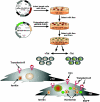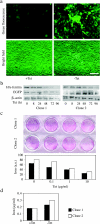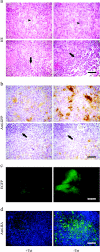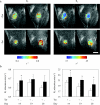Ferritin as an endogenous MRI reporter for noninvasive imaging of gene expression in C6 glioma tumors
- PMID: 15802016
- PMCID: PMC1501126
- DOI: 10.1593/neo.04436
Ferritin as an endogenous MRI reporter for noninvasive imaging of gene expression in C6 glioma tumors
Abstract
The heavy chain of murine ferritin, an iron storage molecule with ferroxidase activity, was developed as a novel endogenous reporter for the detection of gene expression by magnetic resonance imaging (MRI). Expression of both enhanced green fluorescent protein (EGFP) and influenza hemagglutinin (HA)-tagged ferritin were tightly coregulated by tetracycline (TET), using a bidirectional expression vector. C6 cells stably expressing a TET-EGFP-HA-ferritin construct enabled the dynamic detection of TET-regulated gene expression by MRI, followed by independent validation using fluorescence microscopy and histology. MR relaxation rates were significantly elevated both in vitro and in vivo on TET withdrawal, and were consistent with induced expression of ferritin and increase in intracellular iron content. Hence, overexpression of ferritin was sufficient to trigger cellular response, augmenting iron uptake to a degree detectable by MRI. Application of this novel MR reporter gene that generates significant contrast in the absence of exogenously administered substrates opens new possibilities for noninvasive molecular imaging of gene expression by MRI.
Figures






Similar articles
-
MRI detection of transcriptional regulation of gene expression in transgenic mice.Nat Med. 2007 Apr;13(4):498-503. doi: 10.1038/nm1497. Epub 2007 Mar 11. Nat Med. 2007. PMID: 17351627
-
Ferritin reporter used for gene expression imaging by magnetic resonance.Biochem Biophys Res Commun. 2009 Oct 23;388(3):589-94. doi: 10.1016/j.bbrc.2009.08.055. Epub 2009 Aug 14. Biochem Biophys Res Commun. 2009. PMID: 19683514
-
In vivo imaging of tumor transduced with bimodal lentiviral vector encoding human ferritin and green fluorescent protein on a 1.5T clinical magnetic resonance scanner.Cancer Res. 2010 Sep 15;70(18):7315-24. doi: 10.1158/0008-5472.CAN-10-0241. Epub 2010 Sep 7. Cancer Res. 2010. PMID: 20823165
-
Ferritin nanoparticles as magnetic resonance reporter gene.Wiley Interdiscip Rev Nanomed Nanobiotechnol. 2009 Mar-Apr;1(2):181-8. doi: 10.1002/wnan.11. Wiley Interdiscip Rev Nanomed Nanobiotechnol. 2009. PMID: 20049789 Review.
-
Bimodal lentiviral vector encoding myc-tagged human ferritin heavy chain and green fluorescent protein (GFP).2011 Feb 2 [updated 2011 Mar 9]. In: Molecular Imaging and Contrast Agent Database (MICAD) [Internet]. Bethesda (MD): National Center for Biotechnology Information (US); 2004–2013. 2011 Feb 2 [updated 2011 Mar 9]. In: Molecular Imaging and Contrast Agent Database (MICAD) [Internet]. Bethesda (MD): National Center for Biotechnology Information (US); 2004–2013. PMID: 21413198 Free Books & Documents. Review.
Cited by
-
Bioengineered probes for molecular magnetic resonance imaging in the nervous system.ACS Chem Neurosci. 2012 Aug 15;3(8):593-602. doi: 10.1021/cn300059r. Epub 2012 Jul 11. ACS Chem Neurosci. 2012. PMID: 22896803 Free PMC article. Review.
-
Magnetic resonance reporter gene imaging.Theranostics. 2012;2(4):403-12. doi: 10.7150/thno.3634. Epub 2012 Apr 12. Theranostics. 2012. PMID: 22539936 Free PMC article.
-
In vivo MRI cell tracking using perfluorocarbon probes and fluorine-19 detection.NMR Biomed. 2013 Jul;26(7):860-71. doi: 10.1002/nbm.2948. Epub 2013 Apr 22. NMR Biomed. 2013. PMID: 23606473 Free PMC article. Review.
-
Cellular MRI contrast via coexpression of transferrin receptor and ferritin.Magn Reson Med. 2006 Jul;56(1):51-9. doi: 10.1002/mrm.20914. Magn Reson Med. 2006. PMID: 16724301 Free PMC article.
-
Imaging techniques: new avenues in cancer gene and cell therapy.Cancer Gene Ther. 2017 Jan;24(1):1-5. doi: 10.1038/cgt.2016.61. Epub 2016 Nov 11. Cancer Gene Ther. 2017. PMID: 27834357 Review.
References
-
- Sipkins DA, Cheresh DA, Kazemi MR, Nevin LM, Bednarski MD, Li KC. Detection of tumor angiogenesis in vivo by alphaVbeta3-targeted magnetic resonance imaging. Nat Med. 1998;4:623–626. - PubMed
-
- Weissleder R, Moore A, Mahmood U, Bhorade R, Benveniste H, Chiocca EA, Basilion JP. In vivo magnetic resonance imaging of transgene expression. Nat Med. 2000;6:351–355. - PubMed
-
- Winter PM, Morawski AM, Caruthers SD, Fuhrhop RW, Zhang H, Williams TA, Allen JS, Lacy EK, Robertson JD, Lanza GM, Wickline SA. Molecular imaging of angiogenesis in early-stage atherosclerosis with alpha(v)beta3-integrin-targeted nanoparticles. Circulation. 2003;108:2270–2274. - PubMed
-
- Artemov D, Mori N, Ravi R, Bhujwalla ZM. Magnetic resonance molecular imaging of the HER-2/neu receptor. Cancer Res. 2003;63:2723–2727. - PubMed
-
- Kircher MF, Josephson L, Weissleder R. Ratio imaging of enzyme activity using dual wavelength optical reporters. Mol Imaging. 2002;1:89–95. - PubMed
Publication types
MeSH terms
Substances
LinkOut - more resources
Full Text Sources
Other Literature Sources
Medical
